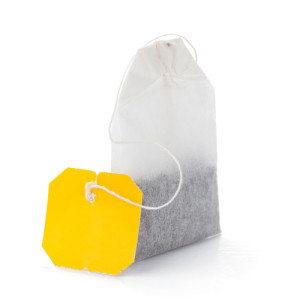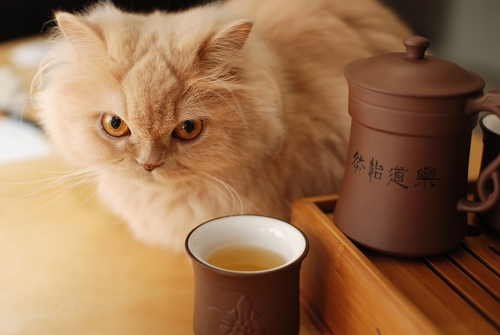 Paper Tea Bags May Be Just as Bad, or Worse…
Paper Tea Bags May Be Just as Bad, or Worse…
The now defunct Dexter Corporation was the initial owner on the patent of a method for treating both tea bags and coffee filters with latex (plastic), to aid in preventing tears that allow the tea leaves/coffee grounds to leak. This invention “saturates and completely impregnates” the entire web material.
Therein lies one of the problems with paper tea bags as they are frequently treated with epichlorohydrin, which hydrolyzes to the carcinogen 3-MCPD when contact with water occurs.
Dow Chemical Co is one of the largest producers of epichlorohydrin. According to safety literature from Dow, it’s a very dangerous chemical that requires using extra precautions when handling. Granted, that doesn’t automatically render it dangerous in the final product, but it can still be a cause for concern, particularly as it can turn into a carcinogen when water is added. There are many unanswered questions with respect to the potential hazards of using this chemical in products specifically designed to be used with boiling water…
A good way to protect yourself and your family in this area is to purchase your tea from manufacturers who can certify that their tea bags do not contain this compound. Organic India, for example, has sent me a confirmation that the paper used for their tea bags does not contain epichlorohydrin. In a 2009 article, Kristie Leong, MD also claims to have done her own inquiries and that Bigelow Tea Company does not use the chemical in their bags. Many plastic tea bags are advertised as “silky” or “mesh bags,” or they’ll have fancy shapes or oversized bags. I’d suggest avoiding those as well if you want to be on the safe side.
Your best option would be to opt for loose tea.
This does take longer, but it can be well worth the wait. One of my favorite teas is Royal Matcha Green Tea, which has one of the highest levels of the potent antioxidant epigallocatechin gallate (EGCG). Unlike other teas which you steep and strain, matcha tea is a powder made from ground green tea leaves. You add the powder right into the water. You are consuming the whole leaf, which makes matcha one of the healthiest green teas available. Another excellent option is loose Tulsi tea leaves. This well-known Ayurvedic herb is also full of antioxidants that fight free radicals in your body and prevent oxidation damage.

How to Brew the Perfect Cup of Tea
There is an art to brewing tea using loose tea leaves, but once you find your “sweet spot” you may never go back to bagged tea again. Here are a few simple guidelines for making the “perfect” cup of tea:
- Bring water to a boil in a tea kettle (avoid using a non-stick pot, as they too can release harmful chemicals when heated)
- Preheat your tea pot or cup to prevent the water from cooling too quickly when transferred. Simply add a small amount of boiling water to the pot or tea cup that you’re going to steep the tea in. Ceramic and porcelain retain heat well. Then cover the pot or cup with a lid. Add a tea cozy if you have one, or drape with a towel. Let stand until warm, then pour out the water
- Put the tea into an infuser, strainer, or add loose into the tea pot. Steeping without an infuser or strainer will produce a more flavorful tea. Start with one heaped teaspoon per cup of tea, or follow the instructions on the tea package. The robustness of the flavor can be tweaked by using more or less tea
- Add boiling water. Use the correct amount for the amount of tea you added (i.e. for four teaspoons of tea, add four cups of water). The ideal water temperature varies based on the type of tea being steeped:
- White or green teas (full leaf): Well below boiling (170-185 F or 76-85 C). Once the water has been brought to a boil, remove from heat and let the water cool for about 30 seconds for white tea and 60 seconds for green tea before pouring it over the leaves
- Oolongs (full leaf): 185-210 F or 85-98 C
- Black teas (full leaf) and Pu-erhs: Full rolling boil (212 F or 100 C)
- Cover the pot with a cozy and let steep. Follow steeping instructions on the package. If there are none, here are some general steeping guidelines. Taste frequently as you want it to be flavorful but not bitter:
- Oolong teas: 4-7 minutes
- Black teas: 3-5 minutes
- Green teas: 2-3 minutes
- Once desired flavor has been achieved you need to remove the strainer or infuser. If using loose leaves, pour the tea through a strainer into your cup and any leftover into another vessel (cover with a cozy to retain heat)
After Water, Tea is One of Your Healthiest Beverage Choices
While some tea bags—whether plastic or paper processed with epichlorohydrin—may pose a potential hazard, please don’t let that deter you from drinking tea altogether. Although I still believe pure water should make up the majority of your daily fluid intake, high-quality tea has numerous health benefits to offer. Among them is growing evidence that the polyphenols in tea, which include EGCG (epigallocatechin gallate) and many others, can be protective against cancer. For example, the polyphenols in green tea appear to be even more effective at fighting the progression of cancer than the antioxidants found in red wine and grapes. Beyond this, the beneficial properties in tea have been known to:
- Neutralize the effects to your body of harmful fats and oils
- Inhibit bacteria and viruses
- Improve digestion
- Protect against oxidation in your brain and liver
- Help promote healthy gums
Drinking tea has also been linked to:
| Improved mental alertness and slowing of brain-cell degeneration | Reduced blood pressure | Protection again type 2 diabetes |
| Lower blood cholesterol and triglyceride levels | Lower risk of breast, colon, lung, ovarian and prostate cancers | Reduced risk of heart attack and stroke |
Of course, there are some general ground rules to follow when selecting tea of any kind, and those are that it should preferably be:
- Organic (otherwise tea may be heavily sprayed with pesticides)
- Grown in a pristine environment (tea is known to accumulate fluoride, heavy metals and other toxins from soil and water, so a clean growing environment is essential to producing a pure, high-quality tea)
So keep these tips in mind, and go ahead and enjoy a cup or two of your favorite variety. I personally prefer Matcha tea, a vibrant bright green tea made of tea leaves ground into a powder, and Tulsi tea, which is a powerful adaptogenic herb that provides important therapeutic benefits.
Bonus:
Read the Green Divas research on the best organic and fair trade early grey tea, with some interesting history about the tea too!
Listen to this excellent Green Divas Radio Show podcast from our feature with Michael Green, executive Director of the Center for Environmental Health, who talked about his work to help protect us from toxins in our environment, including BPA.

lindsay
June 5, 2014 at 8:49 am
Really interesting, thanks for sharing.
Pingback: Why "Clean Coal" is an Oxymoron | Care2 Healthy Living
Pingback: 11 Reasons You Shouldn't Believe in "Clean Coal" - myEARTH360 (the blog)